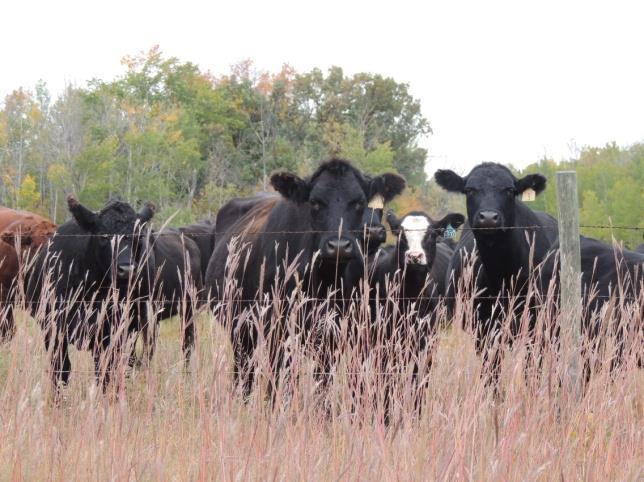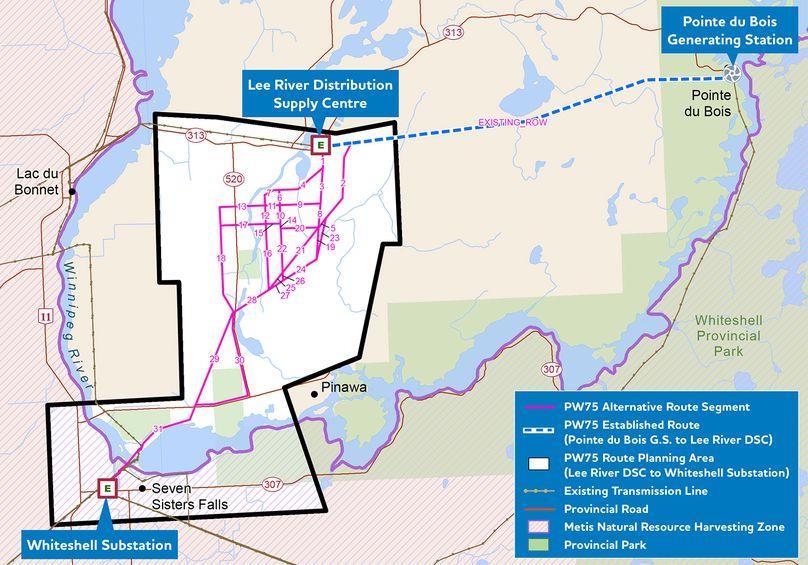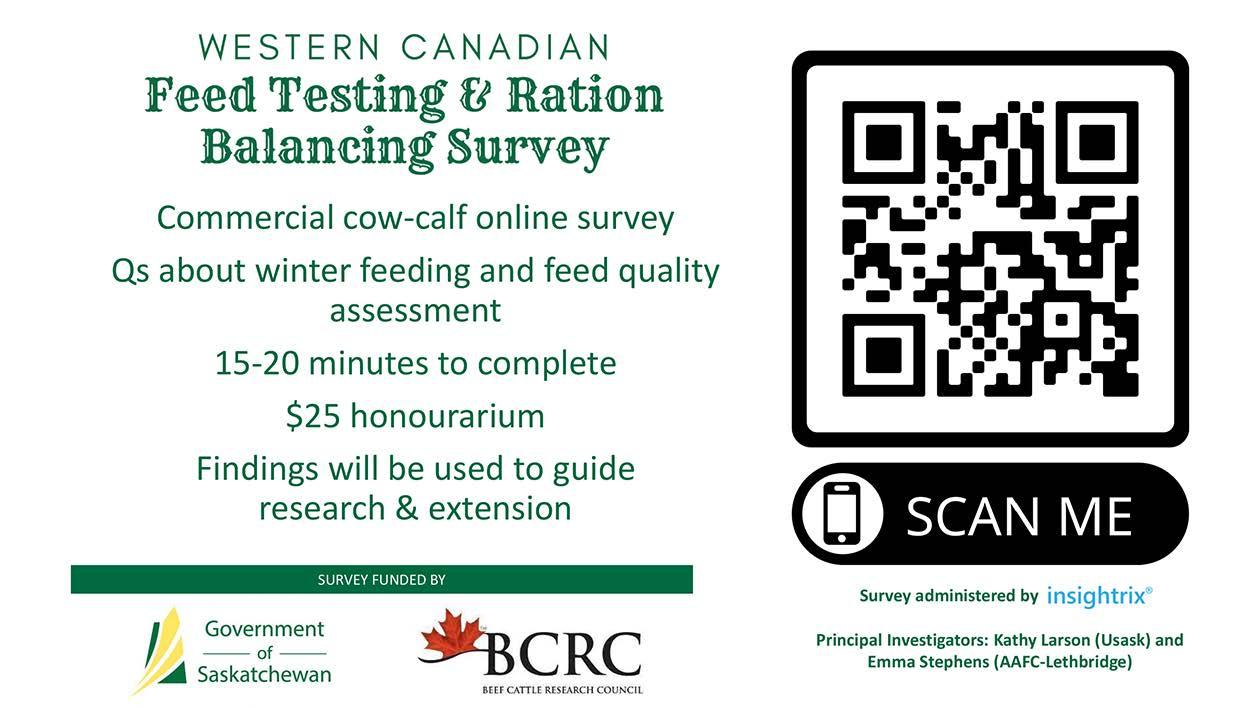E-Newsletter

An update from MBP December 2, 2022 mbbeef.ca





An update from MBP December 2, 2022 mbbeef.ca



(November 30, 2022 Province of Manitoba News Release)

The Manitoba government is announcing the appointment of Brenda DeSerranno as the next deputy minister of agriculture, effective Jan. 7, 2023.
DeSerranno has worked for the Manitoba government since 2005 and has been assistant deputy minister of analytical services at the provincial treasury board secretariat since 2019. In this role, she has gained experience in the programs and services offered by all government departments including Manitoba Agriculture. DeSerranno also has experience in financial and contract management, consultation with stakeholders, real estate management, leased properties and property
management. Her post secondary background includes studies in business administration and urban land economics.
The appointment of DeSerranno will follow the upcoming retirement of Dori Gingera Beauchemin, who has been deputy minister since 2013 and has held many positions during her 43 years with Manitoba Agriculture.
Note: Manitoba Beef Producers looks forward to working with Brenda DeSerranno when she becomes Manitoba's next deputy minister of agriculture in January 2023. Thank you again to Dori Gingera Beauchemin for her many years of dedicated service to the province's agriculture sector.

The following information has been provided by Manitoba’s Emergency Measures Organization.
Manitoba EMO’s Disaster Financial Assistance program is working to issue assistance payments to producers as quickly as possible. For producers that have experienced livestock losses as a result of the 2022 spring flood, please ensure you have submitted the following mandatory documents otherwise your claim cannot be evaluated. Mandatory documents include:
1. A completed and signed Farmland Owner’s Authorization form
2. A completed Insurance Declaration form (completed by your property insurance provider)
3. A signed, original copy of the Financial Assistance Application form
4. Veterinary Certificate completed and signed for verification of livestock loss.
5. Tax information (send copies of all that apply to you):
1. For a farm that is a sole proprietorship, a complete copy of the most recent T1 General income tax return or notarized proof of income and Statements of Income and Expense.
2. For a farm that is a partnership, a copy of your partnership agreement and a complete copy of the most recent T1 General income tax return.
3. For a farm that is a limited company, a copy of your articles of incorporation, a complete copy of the most recent General income tax return and statements of income and expenses.
The documents can be sent via email, fax or by mail. PLEASE INCLUDE YOUR DFA CLAIM NUMBER (200204xxx) WHEN SUBMITTING DOCUMENTS.
Manitoba EMO DFA
Fax: (204) 945 4929 1525 405 Broadway Winnipeg MB R3C 3L6 Toll Free: 1 888 267 8298 dfa@gov.mb.ca
For more information on the disaster financial assistance program, please visit our website at: DFA for Farms
On Sunday, November 27, the Honourable Minister of Foreign Affairs, Melanie Joly, released details on the Government of Canada’s Indo Pacific Strategy (IPS)
The IPS is good news for the Canadian beef industry as the strategy prioritizes trade and agriculture The Indo Pacific region is an important and fast growing export market for Canadian beef with further growth opportunity.
In 2021, our industry hit a new export record high of $4.5 billion of beef exports, the sixth record year in a row. This great success is largely attributed to our increased market access in the Indo Pacific region. 20 per cent of Canada’s beef exports are destined for the Indo Pacific market, with the top five markets being Japan, Mainland China, South Korea, Vietnam, and Hong Kong.
The IPS has five main pillars: (1) strengthening Canada’s role as a reliable and engaged partner to the Indo Pacific, (2) ensuring resilience, peace, and security, (3) expanding trade, investment, and supply chain resilience, (4) investing in and connecting people, and (5) building a sustainable and green future. Some of the strategy’s initiatives of interest to Canadian beef producers include:
Minister led trade missions: $45 million to launch a series of enhanced Minister led trade missions to the Indo Pacific to support exporters and regionally based Canadian Chambers of Commerce in Indo-Pacific markets to facilitate long-term trade and investment opportunities
The Canadian Cattle Association (CCA) has long advocated for participating in trade missions, where there is a lot of value both domestically and internationally. We look forward to participating in the newly launched missions.
Agricultural office in the region: $31.8 million to establish Canada’s first agriculture office in the region to increase and diversify agriculture and agri food exports to the Indo Pacific, strengthening trade on both sides of the Pacific. This is a direct answer to the request CCA made in partnership with other agricultural associations The office will help prevent and resolve non-tariff barriers in the region proactively and quickly. Further the dedicated and resourced market access team will maintain regular contact with agriculture policy makers and regulators in the Indo Pacific, ensuring Canada is at the leading edge of emerging trends in the region and build professional contacts to facilitate communication with foreign officials when required.
The Canadian Indo-Pacific Trade Representative: this new position will advance Canada’s regional trade policy, promotion and economic cooperation objectives in the region, while assisting with any tariff and non tariff barriers in the region. Having strong leadership in the Indo Pacific will help recognize further trade opportunities for Canada, including for the beef sector.
Expanding diplomatic capacity: the government will invest $92.5 million to significantly expand capacity at Canada’s missions in the Indo Pacific and within Global Affairs Canada to
The Canadian Cattle Association is the national voice for Canada’s beef cattle industry representing 60,000 beef farms and feedlots www.cattle.ca

deepen diplomatic, trade, development, and climate ties with regional partners and defend Canadian interests in the region.
CCA continues to share with the Government, the importance of the Indo Pacific from a Canadian beef trade perspective. On behalf of beef producers, we look forward to participating and benefitting from the strategy.
The full IPS can be found here: https://www.international.gc.ca/transparency transparence/indo pacific indo pacifique/index.aspx?lang=eng
For further information, contact: Michelle McMullen
Communications Manager Canadian Cattle Association 403 451 0931| mcmullenm@cattle.ca
The Canadian Cattle Association is the national voice for Canada’s beef cattle industry representing 60,000 beef farms and feedlots www.cattle.ca

Does the animal have a fracture that impedes its mobility or that causes pain or suffering?
The animal is unfit and must not be transported, unless to receive veterinary care as recommended by a veterinarian.
Is the animal able to walk on all its legs?
Is the animal reluctant to walk or walks with halted movements due to pain or suffering (shown by an arched back, head bobs, reluctance to bear weight on a limb, etc.)?
Does the animal walk with a smooth and steady motion, a straight back and normal head carriage while bearing its weight evenly on all limbs?
The animal isn’t lame and may be transported.
The animal is compromised and must be transported as such.
An unfit animal can only be transported (with special provisions) directly to a place to receive veterinary care and under the recommendation of a veterinarian.
A compromised animal can only be transported (with special provisions) directly for slaughter or to a place to receive care for its condition. It can’t be transported to an assembly centre or auction market.
Special provisions if transporting an unfit or compromised animal:
Isolate the animal
or unload the animal alone without using interior ramps
special measures to prevent unnecessary suffering Go directly to the destination
(From the FCC Website) Innovative producers are key to growing a more sustainable future for agriculture. These changes require research, time and capital. By working with industry partners, we’ve created an incentive program open to eligible customers who meet our partners’ program requirements in sustainability. Together, we’re laying the groundwork for future generations to thrive in our industry.
Incentive payments are calculated as a portion of your eligible lending with FCC. You could receive one payment per year at a maximum of $2,000. You can reapply annually throughout the life of the program.
By working with the Canadian Roundtable for Sustainable Beef (CRSB) and its certification bodies (Verified Beef Production Plus, Ontario Corn Fed Beef Quality Assurance Program and Where Food Comes From Inc.), we’ve created an incentive program open to eligible customers who are certified through CRSB.

What's your incentive?
Incentive payments are calculated as a portion of your lending with FCC, excluding operating credit like the FCC Credit Line and FCC Input Financing, to a maximum payment of $2,000 in one year. You can reapply annually throughout the life of the program.
To participate, we’ll need the following information to verify your eligibility and calculate your incentive payment:
• Contact information
• FCC customer number
• Which CRSB approved certification body you’re certified with
• Copy of your registration certificate or certificate of approval showing your CRSB certification
FCC is committed to protecting your personal information. We collect, use, disclose and retain your information to provide services to you and manage your information in accordance with the Privacy Act. Learn more about our commitment to privacy
To be eligible, you must fulfil the following criteria:
• FCC customer in good standing with a balance owing on eligible, existing FCC lending
• CRSB Certified through one of the following verification bodies:
Verified Beef Production Plus (VBP+) Ontario Corn Fed Beef Quality Assurance Program
Where Food Comes From
Applications will close on December 31, 2022 and will re open May 2023






(December 1, 2022 News Release) Manitoba Natural Resources and Northern Development is encouraging all snowmobilers to sled safely this season and advising that conservation officers will be conducting snowmobile patrols to help ensure public safety.
Recreational snowmobilers are reminded that a Snopass permit is required to ride on trails managed by Snoman. A Snopass costs $150 for an annual permit or $75 for a seven day permit and can be purchased through Manitoba Public Insurance. More information is available at https://snoman.mb.ca/snopass.
Manitobans are reminded the following actions can result in provincial fines:
• operating a snowmobile without a Snoman permit ($486 fine);
• operating an unregistered off-road vehicle ($174 fine);

• failure to wear a helmet ($174 fine); and
• public consumption of alcohol ($672 fine).
Impaired operation of a snowmobile carries with it the same consequences as driving a vehicle while impaired. Penalties can include significant fines, impoundment of the snowmobile and a conviction resulting in a criminal record.
Conservation officers and the Royal Canadian Mounted Police play a critical role in monitoring trails for impaired driving offences.
Click here for tickets to the AGM & President's BanquetNote: The following information is taken from Manitoba Hydro’s website: https://www.hydro.mb.ca/projects/system_renewal /pointe_du_bois/
We’re planning a new project to increase Pointe du Bois generating station’s supply of renewable, dependable electricity and enhance our transmission capacity and reliability in the area, so we can get the most value of Manitobans’ investment in this over 110 year old energy asset.
The Pointe du Bois renewable energy project (PREP) is made up of 2 main parts a generating unit replacement in the station’s powerhouse and the construction of a new transmission line in the area.
PREP information sheet – Round 1 (PDF, 846 KB).
We’re planning to install 8 generating units at Pointe du Bois to replace some of the original units that are nearing end of life.
A generating unit is made up of a turbine and generator. Water from the river enters the powerhouse and flows through the turbine, causing the generator to spin to create electricity.
This upgrade will extend the operable life of the station to at least 2055 and increase the amount of renewable, dependable electricity we can produce to meet our customers’ ever growing needs. With 380 gigawatt hours per year, on average, of added production capacity, we will be able to power an extra 35,000 homes in Manitoba.
New transmission line from Pointe du Bois to Whiteshell substation (PW75)
The current transmission lines connecting Pointe du Bois to Manitoba Hydro’s grid are aging and won’t have sufficient capacity to handle the station’s increased electricity output once the new generating units are in place.
We’re planning to construct a new 115 kilovolt (kV) transmission line (referred to as PW75), stretching about 50 kilometres between Pointe du Bois and the existing Whiteshell substation, to deliver more renewable energy and improve reliability for our customers in surrounding areas. This component of the project will require a Class 2 licence under The Environment Act (Manitoba).
The new 115 kV transmission line from Pointe du Bois to Lee River distribution supply centre (DSC) will be routed through an existing right of way currently occupied by a 66 kV transmission line. The existing right of way will be widened to 60 metres (from the current 30 metres) to accommodate the higher voltage line. The existing 66 kV line, which connects Pointe du Bois to Winnipeg, is nearing end of life and will be decommissioned.
A new right of way will be required for the section of the new transmission line between Lee River DSC and Whiteshell substation. Our transmission line routing process and feedback collected through engagement will help determine the preferred route.
Various other upgrades are also planned at Pointe du Bois and Whiteshell substation to accommodate this transmission work.

Alternative route segments for new transmission line.
Enlarge image: Map of southeast Manitoba showing work are between Pointe du Bois and Lac du Bonnet.
A closer look at the alternative route segments.
Enlarge image: Map of southeast Manitoba showing details of work between Lee River DSC and Whiteshell substation.
Visit our interactive map and feedback portal to zoom into the alternative route segments in more detail.

View all materials and maps in our PREP document library.
We have a long history of working in the area and are using what we’ve learned from past projects to help inform how we engage with landowners, interested parties, and the public on the PREP.
Through our First Nation and Métis engagement process, we’ll work directly with First Nation communities, Grand Council Treaty 3, and the Manitoba Métis Federation. We’ll seek to understand concerns, assess potential effects, and work to find ways to address them.
We’ll provide regular updates on the generating unit replacement occurring within the existing footprint of the powerhouse and create opportunities to ask questions and voice concerns.
Our engagement on the new transmission line will provide opportunities for feedback to influence decision making. We’re conducting an environmental assessment to determine a preferred route for the new line and will submit a report to Manitoba Environment, Climate, and Parks for approval before starting construction.
Routing is a key part of the environmental assessment process. Data gathering, on the ground fieldwork, technical, and environmental considerations, and input collected in our engagement will help inform the selection of a preferred route for the new transmission line.
Our engagement to identify and evaluate alternative route segments for the new transmission line is underway.
We encourage you to ask questions, voice your concerns, and share feedback with us to help inform our routing and plans. Check out our engagement opportunities.
Survey now available. Tell us what you think about the alternative route segments. Complete by December 15.
Visit our interactive map and feedback portal to zoom into the alternative route segments in more detail, provide comments and suggestions, flag points of interest, and see what others are saying. The portal is open until December 15, 2022.
• Generating unit replacement:
o Preliminary worksite and equipment preparation: spring 2022;
o Removal of old generating units: fall 2022 to winter 2023;
o New generating unit assembly and installation: spring 2024 to summer 2027.
• New transmission line:
o Identify and evaluate alternative route segments: spring 2022 to fall 2022;
o Preferred route engagement: winter 2023;
o File environmental assessment report for regulatory review: summer 2023;
o Licensing decision: estimated fall 2024;
o Transmission line construction start, if licence approved: fall 2024;
o Target in service date: summer 2027.
This schedule is subject to change.

